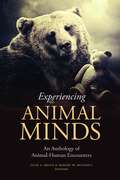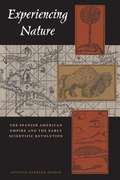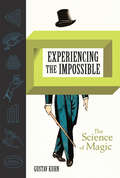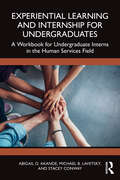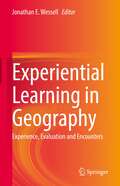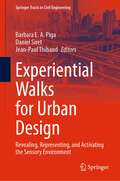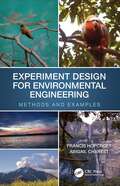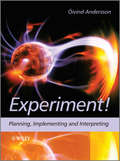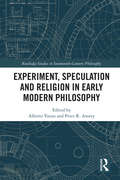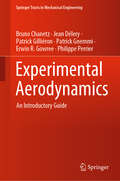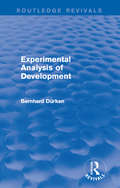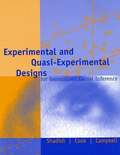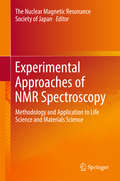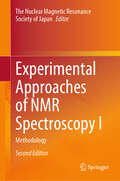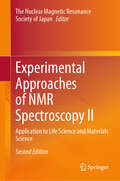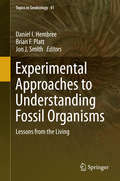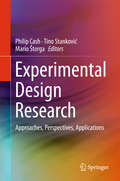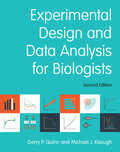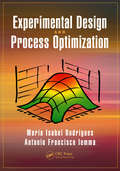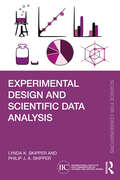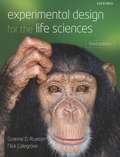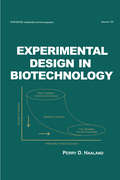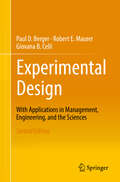- Table View
- List View
Experiencing Animal Minds: An Anthology of Animal-Human Encounters (Critical Perspectives on Animals: Theory, Culture, Science, and Law)
by Robert W. Mitchell. Julie A. Smith EdsIn these multidisciplinary essays, academic scholars and animal experts explore the nature of animal minds and the methods humans conventionally and unconventionally use to understand them. The collection features chapters by scholars working in psychology, sociology, history, philosophy, literary studies, and art, as well as chapters by and about people who live and work with animals, including the founder of a sanctuary for chickens, a fur trapper, a popular canine psychologist, a horse trainer, and an art photographer who captures everyday contact between humans and their animal companions.Divided into five sections, the collection first considers the ways that humans live with animals and the influence of cohabitation on their perceptions of animals' minds. It follows with an examination of anthropomorphism as both a guide and hindrance to mapping animal consciousness. Chapters next examine the effects of embodiment on animals' minds and the role of animal-human interembodiment on humans' understandings of animals' minds. Final sections identify historical representations of difference between human and animal consciousness and their relevance to pre-established cultural attitudes, as well as the ways that representations of animals' minds target particular audiences and sometimes produce problematic outcomes. The editors conclude with a discussion of the relationship between the book's chapters and two pressing themes: the connection between human beliefs about animals' minds and human ethical behavior, and the challenges and conditions for knowing the minds of animals. By inviting readers to compare and contrast multiple, uncommon points of view, this collection offers a unique encounter with the diverse perspectives and theories now shaping animal studies.
Experiencing Nature: The Spanish American Empire and the Early Scientific Revolution
by Barrera-Osorio AntonioHe also conclusively links empiricism to empire-building as he focuses on five areas of Spanish activity in America: the search for commodities in, and the ecological transformation of, the New World; the institutionalization of navigational and information-gathering practices at the Spanish Casa de la Contratación (House of Trade); the development of instruments and technologies for exploiting the natural resources of the Americas; the use of reports and questionnaires for gathering information; and the writing of natural histories about the Americas.
Experiencing the Impossible: The Science of Magic
by Gustav KuhnHow the scientific study of magic reveals intriguing—and often unsettling—insights into the mysteries of the human mind. What do we see when we watch a magician pull a rabbit out of a hat or read a person's mind? We are captivated by an illusion; we applaud the fact that we have been fooled. Why do we enjoy experiencing what seems clearly impossible, or at least beyond our powers of explanation? In Experiencing the Impossible, Gustav Kuhn examines the psychological processes that underpin our experience of magic. Kuhn, a psychologist and a magician, reveals the intriguing—and often unsettling—insights into the human mind that the scientific study of magic provides. Magic, Kuhn explains, creates a cognitive conflict between what we believe to be true (for example, a rabbit could not be in that hat) and what we experience (a rabbit has just come out of that hat!). Drawing on the latest psychological, neurological, and philosophical research, he suggests that misdirection is at the heart of all magic tricks, and he offers a scientific theory of misdirection. He explores, among other topics, our propensity for magical thinking, the malleability of our perceptual experiences, forgetting and misremembering, free will and mind control, and how magic is applied outside entertaiment—the use of illusion in human-computer interaction, politics, warfare, and elsewhere. We may be surprised to learn how little of the world we actually perceive, how little we can trust what we see and remember, and how little we are in charge of our thoughts and actions. Exploring magic, Kuhn illuminates the complex—and almost magical—mechanisms underlying our daily activities.
Experiential Learning and Internship for Undergraduates: A Workbook for Undergraduate Interns in the Human Services Field
by Abigail O. Akande Michael B. Lavetsky Stacey ConwayThis textbook is a comprehensive and sequential guide designed specifically for undergraduate students entering internships in the human services field and for the faculty serving as their internship supervisors. With a strong focus on career development and self-exploration, it builds understanding of the theoretical knowledge and core competencies needed for practical, clinical experience in a variety of human services positions such as rehabilitation, social work, case management, counseling, and criminal justice.Through a variety of exercises and activities in an effective workbook format, this book assists student interns in developing a better sense of self in relation to their career readiness and helps them to identify career paths in the human services field. It goes on to support them in developing the soft skills necessary to navigate professional careers and gives guidance on how to secure undergraduate internships in the human services field. The book focuses on how to develop the tools needed to succeed, from counseling skills, case management, and crisis management to ethical conduct, multicultural considerations, self-care, legislation, and working under supervision. It is accompanied by downloadable versions of all the exercises and activities which will be available for instructors using this book as a course text.By targeting the career exploration content that is vital in the experience of undergraduates who are seeking professions in such a broad human services field, it will be essential reading for students at this level. It is also a valuable resource for internship or practicum instructors in undergraduate programs, with a focus on rehabilitation, human services, social work, psychology, criminal justice, and other related helping fields.
Experiential Learning in Geography: Experience, Evaluation and Encounters
by Jonathan E. WessellThis book provides insight into the importance and impacts that experiential learning has in geographic education by examining the experience, the methods of evaluation, and the encounters that students have shared about their experiences. It allows the reader to gain insight into what it really takes to prepare and lead students in such experiences both domestically and internationally. The book can be used as a guide to planning, but also demonstrates the use of experiential learning theory throughout these experiences and especially the importance of reflection by the students on what they are experiencing. The book is beneficial to students and faculty alike that are studying geography education.
Experiential Walks for Urban Design: Revealing, Representing, and Activating the Sensory Environment (Springer Tracts in Civil Engineering)
by Jean-Paul Thibaud Barbara E. A. Piga Daniel SiretThe edited volume explores the topic of experiential walks, which is the practice of multi- or mono-sensory and in-motion immersion into an urban or natural environment. The act of walking is hence intended as a process of (re-)discovering, reflecting and learning through an embodied experience. Specific attention is devoted to the investigation of the ambiance of places and its dynamic atmospheric perception that contribute to generating the social experience. This topic is gaining increasing attention and has been studied in several forms in different disciplines to investigate the particular spatial, social, sensory and atmospheric character of places. The book contains chapters by experts in the field and covers both the theory and the practice of innovative methods, techniques, and technologies. It examines experiential walks in the perspective of an interdisciplinary approach to environmental and sensory urban design by organising the contributions according to three specific interrelated focuses, namely the exploration and investigation of the multisensory dimension of public spaces, the different ways to grasp and communicate the in-motion experience through traditional and novel forms of representation, and the application of the approach to urban participatory planning and higher education. Shedding new light on the topic, the book offers both a reference guide for those engaged in applied research, and a toolkit for professionals and students.
Experiment Design for Environmental Engineering: Methods and Examples
by Francis J. Hopcroft Abigail CharestExperiment Design for Environmental Engineering provides a wide range of practical environmental engineering laboratory experiments for implementation by students in a university laboratory or by practicing professionals in the field, along with an extensive discussion on how to design an experiment that will provide meaningful and useful data, how to interpret the data generated from an experiment, and how to present those data to an audience of other students or professionals. The example experiments provide a way to evaluate a new design against an existing experiment to determine what information is most appropriate in each section and how to format the data for the most effective outcome. Features Fills in the gap in ABET requirements to teach students how to design experiments and includes key elements for a successful design Covers experiments for a wide range of environmental engineering topics Provides standardized approach that includes a basic background to the concepts and step-by-step procedure for conducting the experiment Explains designs that are suitable for college laboratory and professional applications Shows how to organize experimental data as it is collected to optimize usefulness Provides templates for design of the experiment and for presenting the resulting data to technical and nontechnical audiences or clients
Experiment!
by Oivind AnderssonExperiments are the most effective way to learn about the world. By cleverly interfering with something to see how it reacts we are able to find out how it works. In contrast to passive observation, experimenting provides us with data relevant to our research and thus less time and effort is spent separating relevant from irrelevant information. The art of experimentation is often learnt by doing, so an intuitive understanding of the experimental method usually evolves gradually through years of trial and error. This book speeds up the journey for the reader to becoming a proficient experimenter. Organized in two parts, this unique text begins by providing a general introduction to the scientific approach to experimentation. It then describes the processes and tools required, including the relevant statistical and experimental methods. Towards the end of the book a methodology is presented, which leads the reader through the three phases of an experiment: 'Planning', 'Data Collection', and 'Analysis and Synthesis'. Experiment!Provides an excellent introduction to the methodology and implementation of experimentation in the natural, engineering and medical sciencesPuts practical tools into scientific contextFeatures a number of selected actual experiments to explore what are the key characteristics of good experimentsIncludes examples and exercises in every chapter This book focuses on general research skills, such as adopting a scientific mindset, learning how to plan meaningful experiments and understanding the fundamentals of collecting and interpreting data. It is directed to anyone engaged in experiments, especially Ph.D. and masters students just starting to create and develop their own experiments.
Experiment, Speculation and Religion in Early Modern Philosophy (Routledge Studies in Seventeenth-Century Philosophy)
by Alberto Vanzo Peter R. AnsteyExperimental philosophy was an exciting and extraordinarily successful development in the study of nature in the seventeenth century. Yet experimental philosophy was not without its critics and was far from the only natural philosophical method on the scene. In particular, experimental philosophy was contrasted with and set against speculative philosophy and, in some quarters, was accused of tending to irreligion. This volume brings together ten scholars of early modern philosophy, history and science in order to shed new light on the complex relations between experiment, speculation and religion in early modern Europe. The first six chapters of the book focus on the respective roles of experimental and speculative philosophy in individual seventeenth-century philosophers. They include Francis Bacon, Robert Boyle, Margaret Cavendish, Thomas Hobbes, John Locke and Isaac Newton. The next two chapters deal with the relation between experimental philosophy and religion with a special focus on hypotheses and natural religion. The penultimate chapter takes a broader European perspective and examines the paucity of concerns with religion among Italian natural philosophers of the period. Finally, the concluding chapter draws all these individuals and themes together to provide a critical appraisal of recent scholarship on experimental philosophy. This book is the first collection of essays on the subject of early modern experimental philosophy. It will appeal to scholars and students of early modern philosophy, science and religion.
Experimental Aerodynamics: An Introductory Guide (Springer Tracts in Mechanical Engineering)
by Jean Délery Bruno Chanetz Patrick Gilliéron Patrick Gnemmi Erwin R. Gowree Philippe PerrierThis book presents experimental techniques in the field of aerodynamics, a discipline that is essential in numerous areas, such as the design of aerial and ground vehicles and engines, the production of energy, and understanding the wind resistance of buildings. Aerodynamics is not only concerned with improving the performance and comfort of vehicles, but also with reducing their environmental impact. The book provides updated information on the experimental and technical methods used by aerodynamicists, engineers and researchers. It describes the various types of wind tunnels – from subsonic to hypersonic – as well as the problems posed by their design and operation. The book also focuses on metrology, which has allowed us to gain a detailed understanding of the local properties of flows, and examines current developments toward creating a methodology combining experiments and numerical simulations: the computer-assisted wind tunnel. Lastly, it offers an overview of experimental aerodynamics based on a prospective vision of the discipline, and discusses potential futures challenges. The book can be used as a textbook for graduate courses in aerodynamics, typically offered to students of aerospace and mechanical engineering programs, and as a learning tool for professionals and engineers in the fields of aerodynamics, aeronautics and astronautics automobile.
Experimental Analysis of Development (Routledge Revivals)
by Bernhard DürkenThis book, first published in English in 1932, serves as an introduction to experimental embryology. This title, while covering in-depth the field of investigation, presents the general issues surrounding this particular study rather than just providing an analysis of particular results. This title will be of interest to students of introductory biology and the history of science.
Experimental And Quasi-experimental Designs For Generalized Causal Inference
by Thomas D. Cook Donald T. Campbell William R. ShadishThis long awaited successor of the original Cook/Campbell Quasi-Experimentation: Design and Analysis Issues for Field Settings represents updates in the field over the last two decades. The book covers four major topics in field experimentation.
Experimental Approaches of NMR Spectroscopy
by The Nuclear Magnetic Resonance Society of JapanThis book describes the advanced developments in methodology and applications of NMR spectroscopy to life science and materials science. Experts who are leaders in the development of new methods and applications of life and material sciences have contributed an exciting range of topics that cover recent advances in structural determination of biological and material molecules, dynamic aspects of biological and material molecules, and development of novel NMR techniques, including resolution and sensitivity enhancement. First, this book particularly emphasizes the experimental details for new researchers to use NMR spectroscopy and pick up the potentials of NMR spectroscopy. Second, the book is designed for those who are involved in either developing the technique or expanding the NMR application fields by applying them to specific samples. Third, the Nuclear Magnetic Resonance Society of Japan has organized this book not only for NMR members of Japan but also for readers worldwide who are interested in using NMR spectroscopy extensively.
Experimental Approaches of NMR Spectroscopy I: Methodology
by The Nuclear Magnetic Resonance Society of JapanThis book describes advanced developments in the methodology and applications of NMR spectroscopy in the life science and materials science fields. In this book, new experimental methods and new NMR research fields are presented with chapters on the structure of membrane proteins, in cell NMR, and Electro-Mechano-Optical NMR is added. Experts in the field have contributed an exciting range of topics that cover recent advances in high-pressure NMR, selectively isotope-aided NMR, ultrafast MAS NMR, dynamic nuclear polarization (DNP) NMR, optical and microwave irradiation NMR. This book emphasizes the experimental details for new researchers to use NMR spectroscopy and pick up the potentials of this technique. It is also designed for those who are involved in either developing the technique or expanding the NMR application field by applying them to specific samples. The Nuclear Magnetic Resonance Society of Japan has organized this book not only for NMR users of Japan but also for readers worldwide who are interested in using NMR spectroscopy extensively.
Experimental Approaches of NMR Spectroscopy II: Application to Life Science and Materials Science
by The Nuclear Magnetic Resonance Society of JapanThis book describes advanced developments in the methodology and applications of NMR spectroscopy in the life science and materials science fields. In this book, experts in the NMR field have contributed an exciting range of topics that cover recent advances in structural and dynamic aspects of material molecules such as silk fibrils, polymer materials and organic light-emitting diodes, and biological molecules such as natural products, glycoproteins, and ribonucleic acid (RNA). This book emphasizes the experimental details for new researchers to use NMR spectroscopy and pick up the potential of this technique. It is also designed for those who are involved in either developing the technique or expanding the NMR application field by applying them to specific samples. The Nuclear Magnetic Resonance Society of Japan has organized this book not only for NMR members of Japan but also for readers worldwide who are interested in using NMR spectroscopy extensively.
Experimental Approaches to Understanding Fossil Organisms
by Daniel I. Hembree Brian F. Platt Jon J. SmithPaleontologists and geologists struggle with research questions often complicated by the loss or even absence of key paleobiological and paleoenvironmental information. Insight into this missing data can be gained through direct exploration of analogous living organisms and modern environments. Creative, experimental and interdisciplinary treatments of such ancient-Earth analogs form the basis of Lessons from the Living. This volume unites a diverse range of expert paleontologists, neontologists and geologists presenting case studies that cover a spectrum of topics, including functional morphology, taphonomy, environments and organism-substrate interactions.
Experimental Design Research
by Philip Cash Tino Stanković Mario ŠtorgaThis book presents a new, multidisciplinary perspective on and paradigm for integrative experimental design research. It addresses various perspectives on methods, analysis and overall research approach, and how they can be synthesized to advance understanding of design. It explores the foundations of experimental approaches and their utility in this domain, and brings together analytical approaches to promote an integrated understanding. The book also investigates where these approaches lead to and how they link design research more fully with other disciplines (e. g. psychology, cognition, sociology, computer science, management). Above all, the book emphasizes the integrative nature of design research in terms of the methods, theories, and units of study - from the individual to the organizational level. Although this approach offers many advantages, it has inherently led to a situation in current research practice where methods are diverging and integration between individual, team and organizational understanding is becoming increasingly tenuous, calling for a multidisciplinary and transdiscipinary perspective. Experimental design research thus offers a powerful tool and platform for resolving these challenges. Providing an invaluable resource for the design research community, this book paves the way for the next generation of researchers in the field by bridging methods and methodology. As such, it will especially benefit postgraduate students and researchers in design research, as well as engineering designers.
Experimental Design and Data Analysis for Biologists
by Gerry P. QuinnAn essential textbook for any student or researcher in biology needing to design experiments, sample programs or analyse the resulting data. The text begins with a revision of estimation and hypothesis testing methods, covering both classical and Bayesian philosophies, before advancing to the analysis of linear and generalized linear models. Topics covered include linear and logistic regression, simple and complex ANOVA models (for factorial, nested, block, split-plot and repeated measures and covariance designs), and log-linear models. Multivariate techniques, including classification and ordination, are then introduced. Special emphasis is placed on checking assumptions, exploratory data analysis and presentation of results. The main analyses are illustrated with many examples from published papers and there is an extensive reference list to both the statistical and biological literature. The book is supported by a web-site that provides all data sets, questions for each chapter and links to software.
Experimental Design and Process Optimization
by Maria Isabel Rodrigues Antonio Francisco IemmaExperimental Design and Process Optimization delves deep into the design of experiments (DOE). The book includes Central Composite Rotational Design (CCRD), fractional factorial, and Plackett and Burman designs as a means to solve challenges in research and development as well as a tool for the improvement of the processes already implemented. Appr
Experimental Design and Scientific Data Analysis (Science for Conservators)
by Lynda K. Skipper Philip J. SkipperExperimental Design and Scientific Data Analysis provides accessible information about the research process from start to finish as applied to conservation to enable readers to successfully plan and carry out research and share findings effectively with others.The book is divided into two parts, starting with experimental design in Part 1 and then considering data analysis in Part 2. Part 1 takes the reader through the process of designing and planning experiments, from the initial design of aims and objectives to ethical testing, and includes a range of examples to demonstrate how these ideas apply to a range of specialisms and materials. Part 2 focuses on what to do with data once it has been collected, including choosing the right statistical test, different methods of presenting information, and communicating your findings clearly to your chosen audience. Questions at the end of each chapter are designed to help readers check and consolidate their knowledge of the different topics.Experimental Design and Scientific Data Analysis is suitable for students, emerging professionals, and experienced conservators at different stages of their careers, and is particularly suitable for those without a scientific background.
Experimental Design for the Life Sciences, Third Edition
by Graeme D. Ruxton Nick ColegraveExperimental Design for the Life Sciences, Third Edition, demonstrates how good experimental design relies on clear thinking and biological understanding, not on mathematical or statistical complexity.
Experimental Design in Biotechnology (Statistics: A Series Of Textbooks And Monographs #105)
by Perry D. HaalandThis book provides the first time user of statistics with an understanding of how and why statistical experimental design and analysis can be an effective problem solving tool. It presents experimental designs which are useful for small screening and response surface experiments.
Experimental Design: With Applications In Management, Engineering And The Sciences
by Paul D. Berger Robert E. Maurer Giovana B. CelliCLICHE: nounEtymology: French, literally, printer's stereotype, from past participle of clicher, to stereotype, of imitative originDate: 18921: a trite phrase or expression; also: the idea expressed by it2: a hackneyed theme, characterization, or situation3: something that has become overly familiar or commonplaceIn the words of Stephen Fry, It is a cliche that most cliches are true, but then like most cliches, that cliche is untrue. Cliches are like rationalizations: try going a week without using one. It can't be done They are the hobgoblin of little minds. For most of us, once you begin to take notice, they are fingernails on a chalkboard. From Shakespeare to Shakira; in music, on television, at the movies; in the boardroom, on a conference call, online or in person, cliches have taken over the world. While some nitwits might say they're just misunderstood, they didn't start out that way. There was a time when they were new and vibrant, clever and pithy. Now they're just predictable a vapid collection of much-too-familiar descriptions or metaphors that often replace smart conversation, speech, or writing. This book is a collection of the most overused phrases of all time. Hopefully, it'll make you laugh. Hopefully, it'll make them think. And at the end of the day, if the early bird catches the worm and the slow and steady win the race . . . Please . . . kill . . . me . . . now.
Experimental Electrochemistry: A Laboratory Textbook
by Rudolf HolzeShowing how to apply the theoretical knowledge in practice, the one and only compilation of electrochemical experiments on the market now in a new edition. Maintaining its didactic approach, this successful textbook provides clear and easy-to-follow instructions for carrying out the experiments, illustrating the most important principles and applications in modern electrochemistry, while pointing out the potential dangers and risks involved. This second edition contains 84 experiments, many of which cover electrochemical energy conversion and storage as well as electrochemical equilibrium.
